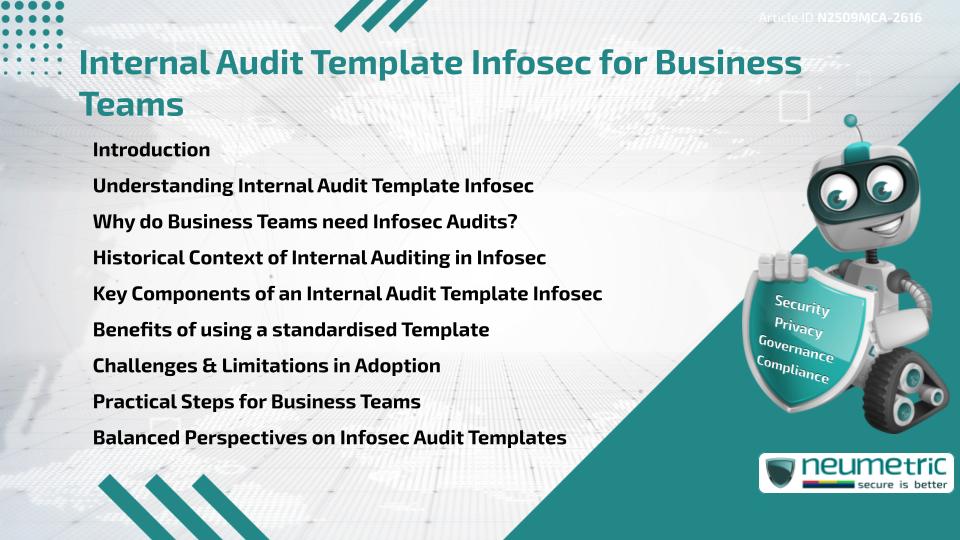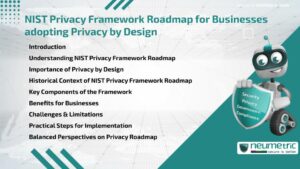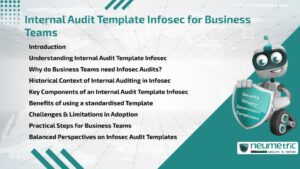Table of Contents
ToggleIntroduction
An Internal Audit Template Infosec provides business teams with a structured guide to evaluate Information Security processes, Risks & Compliance Requirements. By using a standardised template, Organisations can streamline Audits, identify Weaknesses & ensure that Security Measures align with Industry Regulations & company Policies. This approach not only saves time but also builds consistency across different departments.
Understanding Internal Audit Template Infosec
At its core, the Internal Audit Template Infosec is a Checklist or Framework that outlines Critical Areas of Information Security to be reviewed. It simplifies the Audit process by providing predefined sections covering Governance, Access Control, Data Protection & Incident Response. Much like a roadmap, the template ensures that no essential area is overlooked during the Audit, making it easier for business teams to assess Risks systematically.
Why do Business Teams need Infosec Audits?
Business teams handle Sensitive Data, manage Access to systems & play a role in daily operations that impact Security. Regular Audits ensure that these teams follow Best Practices, comply with Policies & prevent Vulnerabilities. An Internal Audit Template Infosec allows teams to proactively detect Gaps before external Audits or Regulators highlight them. This proactive approach builds Trust with Stakeholders & minimises Risks of breaches or fines.
Historical Context of Internal Auditing in Infosec
Internal Audits have long been part of corporate Governance, originally focusing on Financial accuracy & Compliance. Over time, as digital systems became central to business, auditing expanded to include Information Security. The development of Audit templates reflects this evolution, offering a standardised way to manage the complexity of modern infosec environments.
Key Components of an Internal Audit Template Infosec
A well-designed Internal Audit Template Infosec typically includes the following sections:
- Governance & Policies: Reviewing whether Security Policies exist & are followed.
- Access Control: Assessing User rights, Authentication methods & Privileged accounts.
- Data Protection: Ensuring Encryption, Backup & Data Retention practices are in place.
- Incident Response: Evaluating readiness to detect, report & respond to Security Events.
- Compliance & Reporting: Checking alignment with standards such as ISO 27001 or SOC 2.
- Training & Awareness: Reviewing programs to educate Employees on security practices.
These elements ensure comprehensive oversight of both technical & organisational security aspects.
Benefits of using a standardised Template
Adopting an Internal Audit Template Infosec provides several benefits:
- Consistency across multiple business units
- Clear structure for Audit preparation & execution
- Faster identification of Gaps & Risks
- Easier demonstration of Compliance to Regulators & Auditors
- Reduced workload for teams through predefined Audit points
Much like a recipe ensures consistent results in cooking, a template ensures reliable Audit outcomes.
Challenges & Limitations in Adoption
While helpful, Internal Audit templates are not without challenges:
- Risk of becoming a “check-the-box” exercise if used mechanically
- Templates may not fully reflect unique business Risks
- Requires regular updates to stay aligned with evolving Threats & Standards
- Business teams may lack the expertise to interpret technical findings
These challenges highlight the importance of tailoring templates to organisational needs & combining them with skilled oversight.
Practical Steps for Business Teams
To make the most of an Internal Audit Template Infosec, business teams can follow these steps:
- Customise the template to reflect specific Business Operations
- Train team members on how to use the template effectively
- Conduct regular Audits & Document results
- Share findings with leadership to ensure Accountability
- Update the template as Standards & Risks evolve
This process resembles preventive maintenance in engineering-regular, structured & designed to prevent failures before they occur.
Balanced Perspectives on Infosec Audit Templates
Some experts argue that templates may oversimplify complex Security environments. Others highlight their value in providing structure & consistency, especially for teams without deep technical expertise. The best approach is to view the Internal Audit Template Infosec as a starting point rather than a final solution, supplementing it with expert judgment & Continuous Improvement.
Takeaways
- An Internal Audit Template Infosec provides structure for business teams to evaluate Security.
- It covers key areas such as Governance, Access Control & Data Protection.
- Templates offer Consistency, Efficiency & Compliance benefits.
- Challenges include the need for customisation & avoiding a box-ticking mindset.
- Business teams should treat templates as guides, not substitutes for expertise.
FAQ
What is an Internal Audit Template Infosec?
It is a standardised tool or Checklist that guides business teams in auditing Information Security practices & Compliance.
Why should business teams use a template?
It ensures consistency, saves time & helps identify Risks systematically across different departments.
What areas does the template cover?
Key areas include Governance, Access Control, Data Protection, Incident Response & Compliance.
Is the template suitable for all businesses?
Yes, but it should be customised to reflect the unique Risks & requirements of each Organisation.
How often should internal Audits be performed?
At least annually, though high-Risk industries may require quarterly or continuous Audits.
Can templates replace professional auditors?
No, they complement professional Audits by preparing teams & identifying issues early.
What challenges exist in using templates?
Challenges include oversimplification, lack of updates & insufficient expertise in interpreting findings.
How do templates support Compliance?
They help demonstrate adherence to standards like ISO 27001, SOC 2 & GDPR by documenting controls & processes.
Need help for Security, Privacy, Governance & VAPT?
Neumetric provides organisations the necessary help to achieve their Cybersecurity, Compliance, Governance, Privacy, Certifications & Pentesting needs.
Organisations & Businesses, specifically those which provide SaaS & AI Solutions in the Fintech, BFSI & other regulated sectors, usually need a Cybersecurity Partner for meeting & maintaining the ongoing Security & Privacy needs & requirements of their Enterprise Clients & Privacy conscious Customers.
SOC 2, ISO 27001, ISO 42001, NIST, HIPAA, HECVAT, EU GDPR are some of the Frameworks that are served by Fusion – a SaaS, multimodular, multitenant, centralised, automated, Cybersecurity & Compliance Management system.
Neumetric also provides Expert Services for technical security which covers VAPT for Web Applications, APIs, iOS & Android Mobile Apps, Security Testing for AWS & other Cloud Environments & Cloud Infrastructure & other similar scopes.
Reach out to us by Email or filling out the Contact Form…





